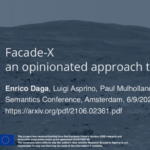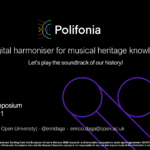Dissemination
This section points to informative material and initiatives presenting Polifonia achievements.
Publications
Cross-Corpus Melodic Similarity For Enriching Archival Collections
Title:Cross-Corpus Melodic Similarity For Enriching Archival Collections
Author:Peter Van Kranenburg, Eoin Kearns
Publication:DLfM ’23
Date:01.11.2023
We present initial results of interlinking several large tune collections. This is achieved through the use of a similarity measure algorithm to create ranked lists and to find highly similar pairs between collections. These pairs can reveal previously unknown links between melodies, allowing for archival enrichment and metadata correction. They can also establish connections between culturally distinct music collections, and allow for a broader understanding of musical heritage. We provide examples of how this algorithm has resulted in corrections and additions to the Dutch Song Database.
The Polifonia Ontology Network: Building a Semantic Backbone for Musical Heritage
Title:The Polifonia Ontology Network: Building a Semantic Backbone for Musical Heritage
Author:Jacopo de Berardinis, Valentina Anita Carriero, Nitisha Jain, Nicolas Lazzari, Albert Meroño-Peñuela, Andrea Poltronieri & Valentina Presutti
Publication:The Semantic Web – ISWC 2023
Date:27.10.2023
In the music domain, several ontologies have been proposed to annotate musical data, in both symbolic and audio form, and generate semantically rich Music Knowledge Graphs. However, current models lack interoperability and are insufficient for representing music history and the cultural heritage context in which it was generated; risking the propagation of recency and cultural biases to downstream applications. In this article, we propose the Polifonia Ontology Network (PON) for music cultural heritage, centred around four modules: Music Meta (metadata), Representation (content), Source (provenance) and Instrument (cultural objects). We design PON with a strong accent on cultural stakeholder requirements and competency questions (CQs), contributing an NLP-based toolkit to support knowledge engineers in generating, validating, and analysing them; and a novel, high-quality CQ dataset produced as a result. We show current and future use of these resources by internal project pilots, early adopters in the music industry, and opportunities for the Semantic Web and Music Information Retrieval communities.In the music domain, several ontologies have been proposed to annotate musical data, in both symbolic and audio form, and generate semantically rich Music Knowledge Graphs. However, current models lack interoperability and are insufficient for representing music history and the cultural heritage context in which it was generated; risking the propagation of recency and cultural biases to downstream applications. In this article, we propose the Polifonia Ontology Network (PON) for music cultural heritage, centred around four modules: Music Meta (metadata), Representation (content), Source (provenance) and Instrument (cultural objects). We design PON with a strong accent on cultural stakeholder requirements and competency questions (CQs), contributing an NLP-based toolkit to support knowledge engineers in generating, validating, and analysing them; and a novel, high-quality CQ dataset produced as a result. We show current and future use of these resources by internal project pilots, early adopters in the music industry, and opportunities for the Semantic Web and Music Information Retrieval communities.
Algorithmic Harmonization of Tonal Melodies Using Weighted Pitch Context Vectors
Title:Algorithmic Harmonization of Tonal Melodies Using Weighted Pitch Context Vectors
Author:Peter Van Kranenburg (Utrecht University, Meertens Institute)*, Eoin J Kearns (Meertens Instituut)
Publication:ISMIR 2023
Date:05.11.2023
Most melodies from the Western common practice period have a harmonic background, i.e., a succession of chords that fit the melody. In this paper we provide a novel approach to infer this harmonic background from the score notation of a melody. We first construct a pitch context vector for each note in the melody. This vector summarises the pitches that are in the preceding and following contexts of the note. Next, we use these pitch context vectors to generate a list of candidate chords for each note. The candidate chords fit the pitch context of a given note each with a computed strength. Finally, we find an optimal path through the chord candidates, employing a score function for the fitness of a given candidate chord. The algorithm chooses one chord for each note, optimizing the total score. A set of heuristics is incorporated in the score function. The system is heavily parameterised, extremely flexible, and does not need training. This creates a framework to experiment with harmonization of melodies. The output is evaluated by an expert survey, which yields convincing and positive results.
The Music Meta Ontology: A Flexible Semantic Model for the Interoperability of Music Metadata
Title:The Music Meta Ontology: A Flexible Semantic Model for the Interoperability of Music Metadata
Author:Valentina Carriero (University of Bologna), Jacopo de Berardinis (King’s College London), Albert Meroño-Peñuela (King’s College London), Andrea Poltronieri (University of Bologna)*, Valentina Presutti (University of Bologna)
Publication:ISMIR 2023
Date:05.11.2023
The semantic description of music metadata is a key requirement for the creation of music datasets that can be aligned, integrated, and accessed for information retrieval and knowledge discovery. It is nonetheless an open challenge due to the complexity of musical concepts arising from different genres, styles, and periods – standing to benefit from a lingua franca to accommodate various stakeholders (musicologists, librarians, data engineers, etc.). To initiate this transition, we introduce the Music Meta ontology, a rich and flexible semantic model to describe music metadata related to artists, compositions, performances, recordings, and links. We follow eXtreme Design methodologies and best practices for data engineering, to reflect the perspectives and the requirements of various stakeholders into the design of the model, while leveraging ontology design patterns and accounting for provenance at different levels (claims, links). After presenting the main features of Music Meta, we provide a first evaluation of the model, alignments to other schema (Music Ontology, DOREMUS, Wikidata), and support for data transformation.
Towards improving Wikidata reuse with emerging patterns
Title:Towards improving Wikidata reuse with emerging patterns
Author:Valentina Anita Carriero, Paul Groth, Valentina Presutti
Publication:3rd Wikidata Workshop 2022, International Semantic Web Conference (ISWC 2022)
Date:24.10.2022
The ontology underlying Wikidata has not been formalized. Instead, its semantics emerges from the use of its classes and properties. Flexible rules and suggestions have been defined by the Wikidata project for the use of its ontology, however, it is still often difficult to reuse the ontology’s constructs. In this paper, we describe a method for extracting emerging patterns from (a domain-specific portion of) Wikidata, in the form of statistically frequent domain-property-range triplets. We show the results of our experiments on a Wikidata subset addressing the music domain, and compare them with the current support present in Wikidata. These patterns can provide guidance for the use of the Wikidata ontology and its potential improvement.
Pitchclass2vec: Symbolic Music Structure Segmentation with Chord Embeddings
Title:Pitchclass2vec: Symbolic Music Structure Segmentation with Chord Embeddings
Author:Nicolas Lazzari, Andrea Poltronieri, Valentina Presutti
Publication:1st Workshop on Artificial Intelligence and Creativity co-located with 21th International Conference of the Italian Association for Artificial Intelligence(AIxIA 2022)
Date:24.03.2023
Structure perception is a fundamental aspect of music cognition in humans. Historically, the hierarchical organization of music into structures served as a narrative device for conveying meaning, creating expectancy, and evoking emotions in the listener. Thereby, musical structures play an essential role in music composition, as they shape the musical discourse through which the composer organises his ideas. In this paper, we present a novel music segmentation method, pitchclass2vec, based on symbolic chord annotations, which are embedded into continuous vector representations using both natural language processing techniques and custom-made encodings. Our algorithm is based on long-short term memory (LSTM) neural network and outperforms the state-of-the-art techniques based on symbolic chord annotations in the field.
The Music Annotation Pattern
Title:The Music Annotation Pattern
Author:Jacopo de Berardinis, Albert Meroño-Peñuela, Andrea Poltronieri, Valentina Presutti
Publication:13th Workshop on Ontology Design and Patterns (WOP2022), International Semantic Web Conference (ISWC 2022)
Date:30.03.2023
The annotation of music content is a complex process to represent due to its inherent multifaceted, subjectivity, and interdisciplinary nature. Numerous systems and conventions for annotating music have been developed as independent standards over the past decades. Little has been done to make them interoperable, which jeopardises cross-corpora studies as it requires users to familiarise with a multitude of conventions. Most of these systems lack the semantic expressiveness needed to represent the complexity of the musical language and cannot model multi-modal annotations originating from audio and symbolic sources. In this article, we introduce the Music Annotation Pattern, an Ontology Design Pattern (ODP) to homogenise different annotation systems and to represent several types of musical objects (e.g. chords, patterns, structures). This ODP preserves the semantics of the object’s content at different levels and temporal granularity. Moreover, our ODP accounts for multi-modality upfront, to describe annotations derived from different sources, and it is the first to enable the integration of music datasets at a large scale.
Observing LOD: Its Knowledge Domains and the Varying Behavior of Ontologies Across Them
Title:Observing LOD: Its Knowledge Domains and the Varying Behavior of Ontologies Across Them
Author:Luigi Asprino, Valentina Presutti
Publication:IEEE Access
Date:27.02.2023
Linked Open Data (LOD) is the largest, collaborative, distributed, and publicly-accessible Knowledge Graph (KG) uniformly encoded in the Resource Description Framework (RDF) and formally represented according to the semantics of the Web Ontology Language (OWL). LOD provides researchers with a unique opportunity to study knowledge engineering as an empirical science: to observe existing modelling practices and possibly understanding how to improve knowledge engineering methodologies and knowledge representation formalisms. Following this perspective, several studies have analysed LOD to identify (mis-)use of OWL constructs or other modelling phenomena e.g. class or property usage, their alignment, the average depth of taxonomies. A question that remains open is whether there is a relation between observed modelling practices and knowledge domains (natural science, linguistics, etc.): do certain practices or phenomena change as the knowledge domain varies? Answering this question requires an assessment of the domains covered by LOD as well as a classification of its datasets. Existing approaches to classify LOD datasets provide partial and unaligned views, posing additional challenges. In this paper, we introduce a classification of knowledge domains, and a method for classifying LOD datasets and ontologies based on it. We classify a large portion of LOD and investigate whether a set of observed phenomena have a domain-specific character.
CLEF. A Linked Open Data native system for Crowdsourcing
Title:CLEF. A Linked Open Data native system for Crowdsourcing
Author:Marilena Daquino, Mari Wigham, Enrico Daga, Lucia Giagnolini, Francesca Tomasi
Publication:Journal on Computing and Cultural Heritage
Date:01.06.2022
Collaborative data collection initiatives are increasingly becoming pivotal to cultural institutions and scholars, to boost the population of born-digital archives. For over a decade, organisations have been leveraging Semantic Web technologies to design their workflows, ensure data quality, and a means for sharing and reusing (Linked Data). Crucially, scholarly projects that leverage cultural heritage data to collaboratively develop new resources would benefit from agile solutions to simplify the Linked Data production workflow via user-friendly interfaces. To date, only a few pioneers have abandoned legacy cataloguing and archiving systems to fully embrace the Linked Open Data (LOD) paradigm and manage their catalogues or research products through LOD-native management systems. In this article we present Crowdsourcing Linked Entities via web Form (CLEF), an agile LOD-native platform for collaborative data collection, peer-review, and publication. We detail design choices as motivated by two case studies, from the Cultural Heritage and scholarly domains respectively, and we discuss benefits of our solution in the light of prior works. In particular, the strong focus on user-friendly interfaces for producing FAIR data, the provenance-aware editorial process, and the integration with consolidated data management workflows, distinguish CLEF as a novel attempt to develop Linked Data platforms for cultural heritage.
Improving Language Model Predictions via Prompts Enriched with Knowledge Graphs
Title:Improving Language Model Predictions via Prompts Enriched with Knowledge Graphs
Author:Ryan Brate, Minh-Hoang Dang, Fian Hoppe, Yuan He, Albert Meroño-Peñuela, Vijay Sadashivaiah
Publication:CEUR-WS Workshop Proceedings
Date:13.04.2023
Despite advances in deep learning and knowledge graphs (KGs), using language models for natural language understanding and question answering remains a challenging task. Pre-trained language models (PLMs) have shown to be able to leverage contextual information, to complete cloze prompts, next sentence completion and question answering tasks in various domains. Unlike structured data querying in e.g. KGs, mapping an input question to data that may or may not be stored by the language model is not a simple task. Recent studies have highlighted the improvements that can be made to the quality of information retrieved from PLMs by adding auxiliary data to otherwise naive prompts. In this paper, we explore the effects of enriching prompts with additional contextual information leveraged from the Wikidata KG on language model performance. Specifically, we compare the performance of naive vs. KG-engineered cloze prompts for entity genre classification in the movie domain. Selecting a broad range of commonly available Wikidata properties, we show that enrichment of cloze-style prompts with Wikidata information can result in a significantly higher recall for the investigated BERT and RoBERTa large PLMs. However, it is also apparent that the optimum level of data enrichment differs between models.
The Harmonic Memory: A Knowledge Graph of harmonic patterns as a trustworthy framework for computational creativity
Title:The Harmonic Memory: A Knowledge Graph of harmonic patterns as a trustworthy framework for computational creativity
Author:Jacopo de Berardinis, Albert Meroño-Peñuela, Andrea Poltronieri, Valentina Presutti
Publication:International World Wide Web Conference (WWW / TheWebConf 2023)
Date:13.04.2023
Computationally creative systems for music have recently achieved impressive results, fuelled by progress in generative machine learn- ing. However, black-box approaches have raised fundamental concerns for ethics, accountability, explainability, and musical plausibility. To enable trustworthy machine creativity, we introduce the Harmonic Memory, a Knowledge Graph (KG) of harmonic patterns extracted from a large and heterogeneous musical corpus. By lever- aging a cognitive model of tonal harmony, chord progressions are segmented into meaningful structures, and patterns emerge from their comparison via harmonic similarity. Akin to a music memory, the KG holds temporal connections between consecutive patterns, as well as salient similarity relationships. After demonstrating the validity of our choices, we provide examples of how this design enables novel pathways for combinational creativity. The memory provides a fully accountable and explainable framework to inspire and support creative professionals – allowing for the discovery of progressions consistent with given criteria, the recomposition of harmonic sections, but also the co-creation of new progressions.
Data journeys: explaining AI workflows through abstraction
Title:Data journeys: explaining AI workflows through abstraction
Author:Enrico Daga; Paul Groth
Publication:Semantic Web (IOS Press)
Date:14.04.2023
Artificial intelligence systems are not simply built on a single dataset or trained model. Instead, they are made by complex data science workflows involving multiple datasets, models, preparation scripts, and algorithms. Given this complexity, in order to understand these AI systems, we need to provide explanations of their functioning at higher levels of abstraction.
To tackle this problem, we focus on the extraction and representation of {\em data journeys} from these workflows. A data journey is a multi-layered semantic representation of data processing activity linked to data science code and assets.
We propose an ontology to capture the essential elements of a data journey and an approach to extract such data journeys.
Using a corpus of Python notebooks from Kaggle, we show that we are able to capture high-level semantic data flow that is more compact than using the code structure itself. Furthermore, we show that introducing an intermediate knowledge graph representation outperforms models that rely only on the code itself. Finally, we report on a user survey to reflect on the challenges and opportunities presented by computational data journeys for explainable AI.
Knowledge Graph Construction From MusicXML: An Empirical Investigation With SPARQL Anything
Title:Knowledge Graph Construction From MusicXML: An Empirical Investigation With SPARQL Anything
Author:Marco Ratta; Enrico Daga
Publication:CEUR-WS
Date:28.10.2022
Multimodal knowledge graphs are gaining momentum because of their ability to integrate multiple types of representations.
In particular, Musical Heritage Knowledge Graphs combine rich contextual information — metadata from encyclopedic KGs, with symbolic content — the scores encoded in a music ontology.
In this paper, we explore the application of SPARQL Anything — a tool for façade-based knowledge graph construction (KGC) — for integrating musical content encoded in MusicXML.
Specifically, we investigate the hypothesis that SPARQL is flexible enough to handle relevant tasks for musical knowledge graph construction such as (a) extracting melodic information, (b) extracting N-grams of musical information, (c) supporting the analysis of those N-grams and (d) populate a musical note ontology.
We contribute a collection of reusable queries for extracting musical features from MusicXML files to construct Musical Knowledge Graphs.
Crucially, we discuss friction points in using the façade-based approach (either in querying the façade or transforming the data) and provide recommendations on how to improve the usability of SPARQL for musical KGC tasks.
Knowledge Graph Construction with a façade: a unified method to access heterogeneous data sources on the Web
Title:Knowledge Graph Construction with a façade: a unified method to access heterogeneous data sources on the Web
Author:Luigi Asprino; Enrico Daga; Paul Mulholland; Aldo Gangemi
Publication:ACM Transactions on Internet Technologies (TOIT)
Date:28.10.2022
Data integration is the dominant use case for RDF Knowledge Graphs. However, Web resources come in formats with weak semantics (for example CSV and JSON), or formats specific to a given application (for example BibTex, HTML, and Markdown). To solve this problem, Knowledge Graph Construction (KGC) is gaining momentum due to its focus on supporting users in transforming data into RDF. However, using existing KGC frameworks result in complex data processing pipelines, which mix structural and semantic mappings, whose development and maintenance constitute a significant bottleneck for KG engineers. Such frameworks force users to rely on different tools, sometimes based on heterogeneous languages, for inspecting sources, designing mappings, and generating triples, thus making the process unnecessarily complicated. We argue that it is possible and desirable to equip KG engineers with the ability of interacting with Web data formats by relying on their expertise in RDF and the well-established SPARQL query language.
In this article, we study a unified method for data access to heterogeneous data sources with Facade-X, a meta-model implemented in a new data integration system called SPARQL Anything. We demonstrate that our approach is theoretically sound, since it allows a single meta-model, based on RDF, to represent data from (a) any file format expressible in BNF syntax, as well as (b) any relational database. We compare our method to state-of-the-art approaches in terms of usability (cognitive complexity of the mappings) and general performance. Finally, we discuss the benefits and challenges of this novel approach by engaging with the reference user community.
The Music Annotation Pattern
Title:The Music Annotation Pattern
Author:Jacopo de Berardinis, Albert Meroño-Peñuela, Andrea Poltronieri and Valentina Presutti
Publication:Workshop on Ontology Design Patterns (WOP)
Date:31.10.2022
The annotation of music content is a complex process to represent due to its inherent multifaceted, subjectivity, and interdisciplinary nature. Numerous systems and conventions for annotating music have been developed as independent standards over the past decades. Little has been done to make them interoperable, which jeopardises cross-corpora studies as it requires users to familiarise with a multitude of conventions. Most of these systems lack the semantic expressiveness needed to represent the complexity of the musical language and cannot model multi-modal annotations originating from audio and symbolic sources. In this article, we introduce the Music Annotation Pattern, an Ontology Design Pattern (ODP) to homogenise different annotation systems and to represent several types of musical objects (e.g. chords, patterns, structures). This ODP preserves the semantics of the object’s content at different levels and temporal granularity. Moreover, our ODP accounts for multi-modality upfront, to describe annotations derived from different sources, and it is the first to enable the integration of music datasets at a large scale.
Towards improving Wikidata reuse with emerging patterns
Title:Towards improving Wikidata reuse with emerging patterns
Author:Valentina Anita Carriero, Paul Groth and Valentina Presutti
Publication:Wikidata Workshop
Date:31.10.2022
The ontology underlying Wikidata has not been formalized. Instead, its semantics emerges from the use of its classes and properties. Flexible rules and suggestions have been defined by the Wikidata project for the use of its ontology, however, it is still often difficult to reuse the ontology’s constructs. In this paper, we describe a method for extracting emerging patterns from (a domain-specific portion of) Wikidata, in the form of statistically frequent domain-property-range triplets. We show the results of our experiments on a Wikidata subset addressing the music domain, and compare them with the current support present in Wikidata. These patterns can provide guidance for the use of the Wikidata ontology and its potential improvement.
Image: see attachment
ARTchives: a Linked Open Data native catalogue of art historians’ archives
Title:ARTchives: a Linked Open Data native catalogue of art historians’ archives
Author:Marilena Daquino, Lucia Giagnolini, Francesca Tomasi
Publication:Theory and Practice of Digital Libraries (TPDL)
Date:25.11.2021
Proceedings of Linked Archives International Workshop 2021 co-located with 25th International Conference on Theory and Practice of Digital Libraries (TPDL 2021).
Semantic Integration of MIR Datasets with the Polifonia Ontology Network
Title:Semantic Integration of MIR Datasets with the Polifonia Ontology Network
Author:Valentina Anita Carriero, Fiorela Ciroku, Jacopo de Berardinis, Delfina Sol Martínez Pandiani, Albert Meroño-Peñuela, Andrea Poltronieri, Valentina Presutti.
Publication:International Society for Music Information Retrieval Conference (ISMIR 2021), Late Breaking & Demo session (2021)
Date:01.11.2021
Integration between different data formats, and between data belonging to different collections, is an ongoing challenge in the MIR field. Semantic Web tools have proved to be promising resources for making different types of music information interoperable. However, the use of these technologies has so far been limited and scattered in the field. To address this, the Polifonia project 1
is developing an ontological ecosystem that can cover a wide variety of musical aspects (musical features, instruments, emotions, performances). In this paper, we present the Polifonia Ontology Network, an ecosystem that enables and fosters the transition towards Semantic MIR.
MIDI Representation with Graph Embeddings
Title:MIDI Representation with Graph Embeddings
Author:Pasquale Lisena, Albert Meroño-Peñuela, Raphaël Troncy
Publication:International Society for Music Information Retrieval Conference (ISMIR 2021), Late Breaking & Demo session (2021)
Date:01.11.2021
In MIR, feature extraction has been extensively used for learning models of MIDI. We propose an alternative approach that relies on the extraction of latent features from a graph of connected nodes. We show that our MIDI2vec approach has good performance in metadata prediction.
MIDI2vec: Learning MIDI Embeddings for Reliable Prediction of Symbolic Music Metadata
Title:MIDI2vec: Learning MIDI Embeddings for Reliable Prediction of Symbolic Music Metadata
Author:Pasquale Lisena, Albert Meroño-Peñuela, Raphaël Troncy
Publication:IOS Press (2021)
Date:01.09.2021
An important problem in large symbolic music collections is the low availability of high-quality metadata, which is essential for various information retrieval tasks. Traditionally, systems have addressed this by relying either on costly human annotations or on rule-based systems at a limited scale. Recently, embedding strategies have been exploited for representing latent factors in graphs of connected nodes. In this work, we propose MIDI2vec, a new approach for representing MIDI files as vectors based on graph embedding techniques. Our strategy consists of representing the MIDI data as a graph, including the information about tempo, time signature, programs and notes. Next, we run and optimise node2vec for generating embeddings using random walks in the graph. We demonstrate that the resulting vectors can successfully be employed for predicting the musical genre and other metadata such as the composer, the instrument or the movement. In particular, we conduct experiments using those vectors as input to a Feed-Forward Neural Network and we report good comparable accuracy scores in the prediction with respect to other approaches relying purely on symbolic music, avoiding feature engineering and producing highly scalable and reusable
models with low dimensionality. Our proposal has real-world applications in automated metadata tagging for symbolic music, for example in digital libraries for musicology, datasets for machine learning, and knowledge graph completion.
Integrating citizen experiences in cultural heritage archives: requirements, state of the art, and challenges
Title:Integrating citizen experiences in cultural heritage archives: requirements, state of the art, and challenges
Author:Daga, Enrico; Asprino, Luigi; Damiano, Rossana; Daquino, Marilena; Diaz Agudo, Belen; Gangemi, Aldo; Kuflik, Tsvi; Lieto, Antonio; Marras, Anna Maria; Martinez Pandiani, Delfina; Mulholland, Paul; Peroni, Silvio; Pescarin, Sofia; Wecker, Alan.
Publication:ACM JOCCH (2021)
Date:01.01.2021
Digital archives of memory institutions are typically concerned with the cataloguing of artefacts of artistic, historical, and cultural value. Recently, new forms of citizen participation in cultural heritage have emerged, producing a wealth of material spanning from visitors’ experiential feedback on exhibitions and cultural artefacts, to digitally mediated interactions like the ones happening on social media platforms. Citizen curation is proposed in the context of the European project SPICE – Social Participation, Cohesion, and Inclusion through Cultural Engagement – as a methodology for producing, collecting, interpreting, and archiving people’s responses to cultural objects, with the aim of favouring the emergence of multiple, sometimes conflicting viewpoints, and motivating users and memory institutions to reflect upon them.
We argue that citizen curation urges to rethink the nature of computational infrastructures supporting data management of memory institutions, bringing novel challenges that include issues of distribution, authoritativeness, interdependence, privacy, and rights management. To approach these issues, we survey relevant literature towards a distributed, Linked Data infrastructure, with a focus on identifying the roles and requirements involved in such an infrastructure. We show how existing research can contribute significantly in facing the challenges raised by citizen curation, and discuss challenges and opportunities from the socio-technical standpoint.
The Polifonia portal: a confluence of user stories, research pilots, data management and knowledge graph technology
Title:The Polifonia portal: a confluence of user stories, research pilots, data management and knowledge graph technology
Author:Scharnhorst Andrea, Admiraal Femmy, van Kranenburg Peter, Guillotel-Nothmann Christophe, Mulholland Paul
Publication:DARIAH Annual event
Date:07.09.2021
This paper takes as an example the envisioned portal of the newly started Polifonia project that interlinks resources from very rich, old, established archives while making optimal use of the latest semantic web technologies. In the project, ten research pilots, spanning from historical bells and organ heritage, classification of polyphonic notated music, to the historical role of music in children’s lives, form the driving force behind the development of the dedicated interface.
Sequential Linked Data: the State of Affairs
Title:Sequential Linked Data: the State of Affairs
Author:Enrico Daga, Albert Meroño-Peñuela, Enrico Motta
Publication:Semantic Web–Interoperability, Usability, Applicability (2021): In-press.
Date:21.07.2021
Software and data for the experiments in “Sequential Linked Data: the state of affairs”
Facade-X: an Opinionated Approach to SPARQL Anything
Title:Facade-X: an Opinionated Approach to SPARQL Anything
Author:Enrico Daga, Luigi Asprino, Paul Mulholland, Aldo Gangemi
Publication:SEMANTICS 2021, Amsterdam, September 2021. arXiv preprint arXiv:2106.02361 (2021).
Date:21.07.2021
SPARQL-Anything/sparql.anything
Public Deliverables
Analysis of music repositories to identify musical patterns
Title:Analysis of music repositories to identify musical patterns
Author:James McDermott (NUIG) and Danny Diamond (NUIG) and Abdul Shahid Khattak (NUIG) and Peter van Krannenburg (KNAW) and Jacopo de Berardinis (KCL) and Andrea Poltron- ieri (UNIBO) and Albert Meroño Peñuela (KCL) and Raphaël Fournier-S’niehotta (CNAM) and Tiange Zhu (CNAM)
Publication:Report
Date:31.12.2021
Deliverable D3.2
Report on experiments with music representations to identify statistically significant patterns in available repositories of structured music information.
Policy brief
Title:Policy brief
Author:Jesse de Vos (NISV, task leader), Valentina Presutti (UNIBO), Albert Merona Penuela (KCL), Marilena Daquino (UNIBO), James McDermott (NUI GALWAY), Marco Gurrieri (CNRS), Enrico Daga (OU), Andrea Scharnhorst (KNAW), Nicole Emmenegger (NISV)
Publication:Report
Date:31.12.2021
Deliverable D6.4
Reports, in the form or recommendation targeting policy makers, a summary of the project results so far and the lessons learned by all partners. (1st version)
Roadmap and pilot requirements 1st version
Title:Roadmap and pilot requirements 1st version
Author:Thomas Bottini (CNRS-IReMus), Valentina Anita Carriero (UNIBO), Jason Carvalho (OU), Philippe Cathé (Sorbonne-IReMus), Fiorela Ciroku (UNIBO), Enrico Daga (OU), Marilena Daquino (UNIBO), Achille Davy-Rigaux (CNRS-IReMus), Christophe Guillotel-Nothmann (CNRS-IReMus) [Task leader], Marco Gurrieri (CNRS-IReMus), Philo van Kemenade (NISV), Eleonora Marzi (UNIBO), Albert Meroño Peñuela (KCL), Paul Mulholland (OU), Elena Musumeci (MiC), Valentina Presutti (UNIBO), Andrea Scharnhorst (KNAW)
Publication:Report
Date:30.06.2021
Deliverable D1.1
Outlines the modalities by which the resources, needs, objectives and quality standards of the pilots will be defined.
Pilots development – collaborative methodology and tools
Title:Pilots development – collaborative methodology and tools
Author:Enrico Daga The Open University (OU), Albert Merono (KCL), Marilena Daquino and Fiorela Ciroku (UNIBO), Elena Musumeci (MiC), Marco Guerrieri (CNRS), Andrea Scharnhorst and Femmy Admiraal (KNAW), Raphaël Fournier-S’niehotta (CNAM)
Publication:Report
Date:30.06.2021
Deliverable D1.3
Describes the role of the Technical Board and the methods and tools used to support the collaboration and coordination of technical efforts from the partners towards the realisation of the ecosystem of software and tools supporting the pilots
First Data Management Plan
Title:First Data Management Plan
Author:Femmy Admiraal (KNAW) Task lead, Andrea Scharnhorst (KNAW) Task lead, Enrico Daga (OU), Marilena Daquino (UNIBO), Elena Musumeci (MiC), Peter van Kranenburg (KNAW), Christophe Guillotel-Nothmann (CNRS-IReMus), Marco Gurrieri (CNRS-IReMus), Valentina Presutti (UNIBO), Marta Clementi (UNIBO), Albert Meroño Peñuela (KCL), Monica Turci (UNIBO), Eleonora Marzi (UNIBO), Antonio Puglisi (DP), Raphaël Fournier-S’niehotta (CNAM)
Publication:ORDP: Open Research Data Pilot
Date:30.06.2021
Deliverable D7.1
First version of a Data Management Plan (DMP) to support the management of the outputs of the project during the development of the project, and after the project has ended.
Web presence and Polifonia image
Title:Web presence and Polifonia image
Author:Antonio Puglisi (DP, Task Leader); Letizia Scalise and Danilo Di Capua (DP); Yasemin Bagci (NISV)
Publication:Report
Date:28.02.2021
Deliverable D6.6
Development of a digital communication plan to present Polyphony and the results achieved by the project.
Development of the brand image of the project and the required communication materials.
Plan for Exploitation, Dissemination and Communication of Results – 1st version
Title:Plan for Exploitation, Dissemination and Communication of Results – 1st version
Author:Yasemin Bagci and Jesse de Vos (NISV, Task Leaders); Nicole Emmenegger (NISV)
Publication:Report
Date:30.06.2021
Deliverable D6.1
The initial strategy for project dissemination and communication. This is based on a needs analysis of the different target user groups. Start of the Dissemination and Communication Team and the initiation of the editorial outreach calendar.
Plurilingual corpora containing source texts in English, French, Spanish and German
Title:Plurilingual corpora containing source texts in English, French, Spanish and German
Author:Rocco Tripodi, UNIBO; Eleonora Marzi, UNIBO; Andrea Poltronieri, UNIBO; Valentina Presutti, UNIBO; Angelo Pombilio, UNIBO; Antonella Luporini, UNIBO; Peter van Kranenburg – KNAW; Entico Daga – OU
Publication:Other
Date:30.10.2021
Deliverable D4.1
Release of plurilingual corpora containing source texts in English, French, Spanish and German
Software tool for pattern extraction
Title:Software tool for pattern extraction
Author:Danny Diamond (NUIG) and Abdul Sahid and James McDer- mott (NUIG), and Jacopo de Berardinis (KCL) and Andrea Poltronieri (UNIBO) and Peter van Kranenburg (KNAW)
Publication:Other
Date:31.12.2021
Deliverable D3.1
Open source software and documentation for the task of extracting musically meaningful repeating patterns from a corpus of melodies.
Ontologies and knowledge graphs of music objects, patterns, and software package – 1st version
Title:Ontologies and knowledge graphs of music objects, patterns, and software package – 1st version
Author:Albert Meroño-Peñuela (KCL), Jacopo de Berardinis (KCL), Delfina Sol Martinez Pandiani (UNIBO), Valentina Anita Carriero (UNIBO), Mari Wigham (NISV), Andrea Poltronieri (UNIBO), Fiorela Ciroku (UNIBO), Christophe Guillotel-Nothmann (IReMus), Philippe Rigaux (IReMuS)
Publication:Other
Date:31.12.2021
Deliverable D2.1
Description of ontologies for musical objects (Score Ontology), patterns (Musicianship Ontology), and musical heritage metadata. Technical report of the software that transforms music collections into knowledge graphs according to these ontologies.
Talks and presentations

Progetto H2020 Polifonia: lessico multilingue per un Knowledge Graph del patrimonio musicale europeo
Presented by: Eleonora Marzi, Ana Pano Alaman, Angelo Pompilio, Valentina Presutti, Rocco Tripodi, Monica Turci, Valeria Zotti, Peter van Kranenburg
Presented at: XVIII Giornata Scientifica REALITER
Find the programme here.
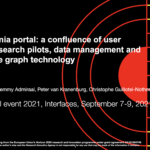
The Polifonia portal: a confluence of user stories, research pilots, data management and knowledge graph technology
Conference Paper presentation by Scharnhorst, Andrea, Admiraal, Femmy, van Kranenburg, Peter, Guillotel-Nothmann, Christophe, & Mulholland, Paul at DARIAH Annual event 2021, Interfaces
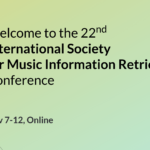
Semantic Integration of MIR Datasets with the Polifonia Ontology Network
Conference Paper presentation by Valentina Anita Carriero, Fiorela Ciroku, Jacopo de Berardinis, Delfina Sol Martínez Pandiani, Albert Meroño-Peñuela, Andrea Poltronieri, Valentina Presutti at ISMIR 2021
Find the event website here.

MIDI Representation with Graph Embeddings
Conference Paper presentation by Pasquale Lisena, Albert Meroño-Peñuela, Raphaël Troncy at ISMIR 2021
Find the event website here.
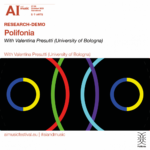
Demo Research: Polifonia
Polifonia presented its first demo research at the Sonar AI Music and Festival (27.28 October 2021) in Barcelona.
